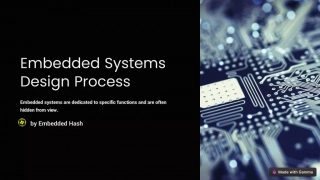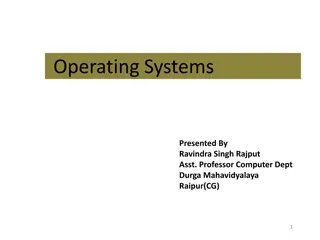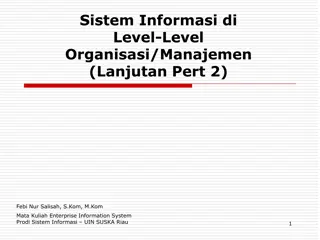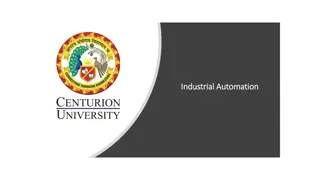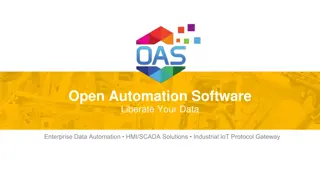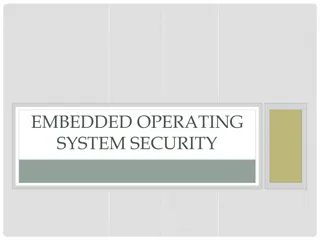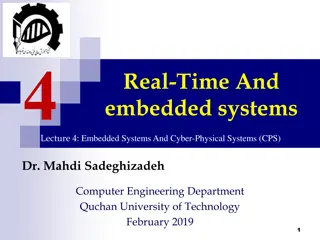SCADA Systems
SCADA, or Supervisory Control and Data Acquisition, is a system used in various industries like chemical, power generation, and experimental physics. It involves hardware, software, and functionality to control and monitor processes. Learn about the generations, architecture, advantages, and disadvantages of SCADA systems.
Download Presentation

Please find below an Image/Link to download the presentation.
The content on the website is provided AS IS for your information and personal use only. It may not be sold, licensed, or shared on other websites without obtaining consent from the author.If you encounter any issues during the download, it is possible that the publisher has removed the file from their server.
You are allowed to download the files provided on this website for personal or commercial use, subject to the condition that they are used lawfully. All files are the property of their respective owners.
The content on the website is provided AS IS for your information and personal use only. It may not be sold, licensed, or shared on other websites without obtaining consent from the author.
E N D
Presentation Transcript
www.studymafia.org SCADA Submitted To: www.studymafia.org Submitted By: www.studymafia.org
Contents.. Introduction Scada Generations Hardware Architecture Software Architecture Functionality Conclusion Advantages Disadvantages References
Introduction What is SCADA? What is data acquisition? Where and why, use of SCADA? Application area : Industrial processes : chemical, power generation and Nuclear processes : reactors, nuclear waste, ... Experimental physics : HEP laboratories Application size: 20 k I/O to 450 K I/O, 1 M I/O under development distribution, metallurgy,
ERP Systems Expert Systems SCADA ? Data Acquisition Supervisory Control And Archiving, Logging, Access Control, Alarms Graphics and Batch processing Distributed database Data Server Data Server PLC s Field Bus Control Programs
SCADA generations 1st generation (1970s). Co-located control Controlled units were on the same site as the controlling computer with hard-wired connections between them No network so no potential for external attack. Very limited chance of insider attack because operation by teams rather than individuals
SCADA generations 2nd generation (1980s/90s) Distributed control SCADA systems networked with devices using special-purpose protocols No external network connection Vulnerable to insider attacks because of distributed sites
SCADA generations 3rd generation (2000s). Networked systems SCADA systems no longer isolated but connected to external networks External connection through computers (particularly PCs) that are directly connected to the Internet May also interface with other Internet-connected systems such as manufacturing control systems More use of standard protocols such as TCP/IP for communications Remote system monitoring and upgrades from providers requires network connection
Architecture Hardware Software
Hardware Typical Hardware Architecture
Software Architecture Communication Internal Communication Access to Devices Interfacing H/W Multiple communication protocols supported in a single system Support for major PLCs/DCSs but not VME S/W API ODBC, DDE and OLE I/F to PC Products OPC Client and OPC Server ActiveX Containers Scalability Database Configuration DB, alarm DB, Archive DB, log DB and RTDB resides in the memory of the servers
Functionality Generic SCADA functionality Access Control, MMI, Trending, Alarm Handling, Logging, Archiving, Report Generation, Automation.
Functionality Contd.. Access Control Users - allocated to groups group - defined read/write access MMI multiple screens library of standard graphical symbols dragged and dropped zooming, re-sizing, scrolling... Links - pages to navigate
Functionality Contd.. Trending Alarm Handling based on limit and status checking handled centrally E-mailscan be generated based on parameters on specific chart can be predefined or defined on-line more than 8 trended parameters per chart both real-time and historical trending zooming and scrolling
Functionality Contd.. Logging, Archiving Data stored in compressed and proprietary format Logging / Archiving either for a set number of parameters or for a set period of time Logging / Archiving can be frequency or event driven * Logging of user actions together with a user ID VCR facility for playback of stored data Writing logs into RTDB Report Generation Reports created using SQL type queries to the RTDB or logs Automatic generation, printing and archiving of reports Use of components for report generation
Functionality Contd.. Automation triggered by events defined in scripting languages send e-mail ,write into RTDB recipes Sequencing
Development Tools Project editor Graphics editor Configuration through parameter templates Scripting language Driver Development Tool Kit And more
Data Access Mechanism's Alarm Server Alarm Server typically poll data from the data server ( -> impact on network bandwidth) More advanced techniques like publish / subscribe are available in some cases Data Server Data from field buses are mainly polled Field Bus
Advantages of SCADA The system provide facility to store large amount of data. The data can be displayed in various formats as per user requirements. It provides interface to connect thousands of sensors across wide region for various monitoring and controlling operations. It is possible to obtain real data simulations with the help of operators. Many types of data can be gathered from RTUs (Remote Terminal Units) connected with the master unit. It is fast in obtaining response.
Disadvantages of SCADA PLC based SCADA system is complex in terms of hardware units and dependent modules. As the system is complex, it requires skilled operators, analysts and programmers to maintain SCADA system. Installation costs are higher. The system increases unemployment rates. The system supports use of restricted softwares and hardware equipments.
Conclusion SCADA is a control system with More frond end functionality More interfaces and efficient storage More record or device oriented configuration but System wide configuration tools are needed are less expensive than DCS, but offer different functionality than DCS And finally various applications
References www.scadanews.com 1. Google 2. Wikipedia 3. www.Studymafia.org 4. www.scada.com 5.



